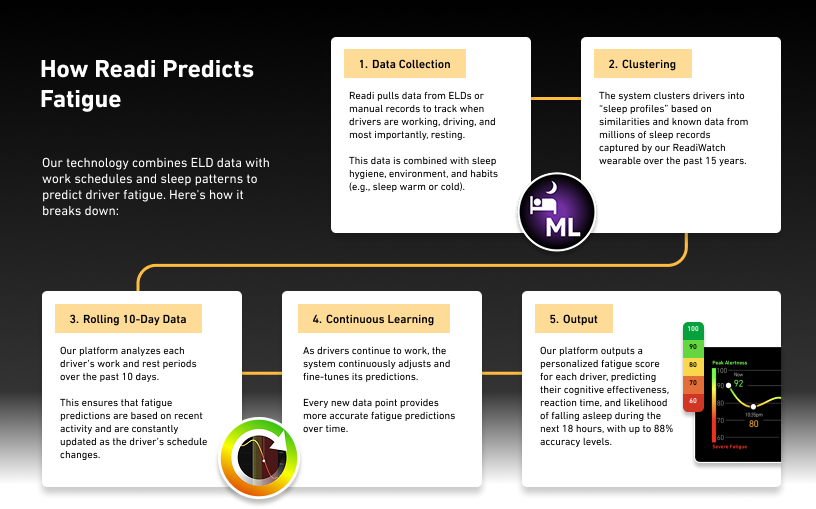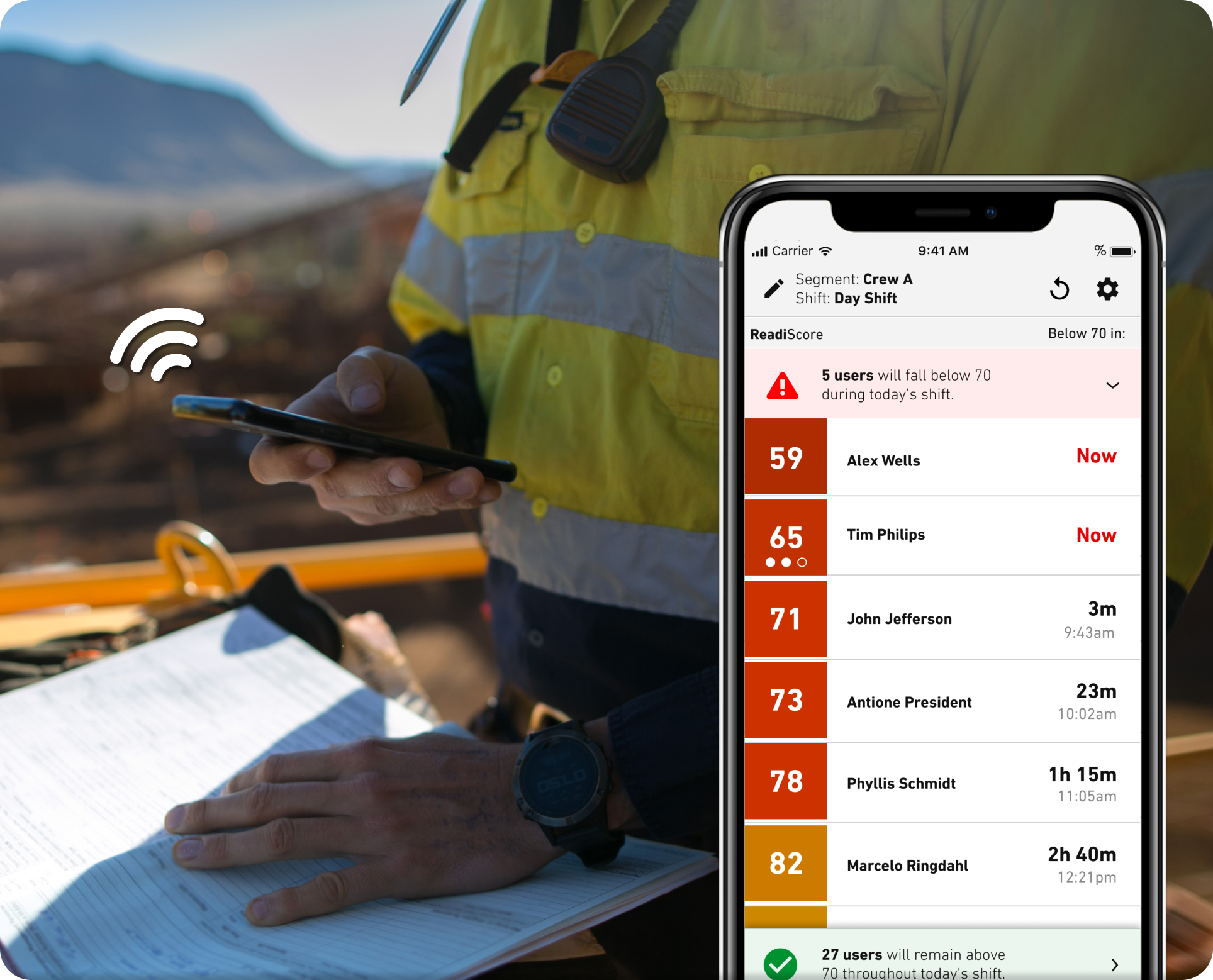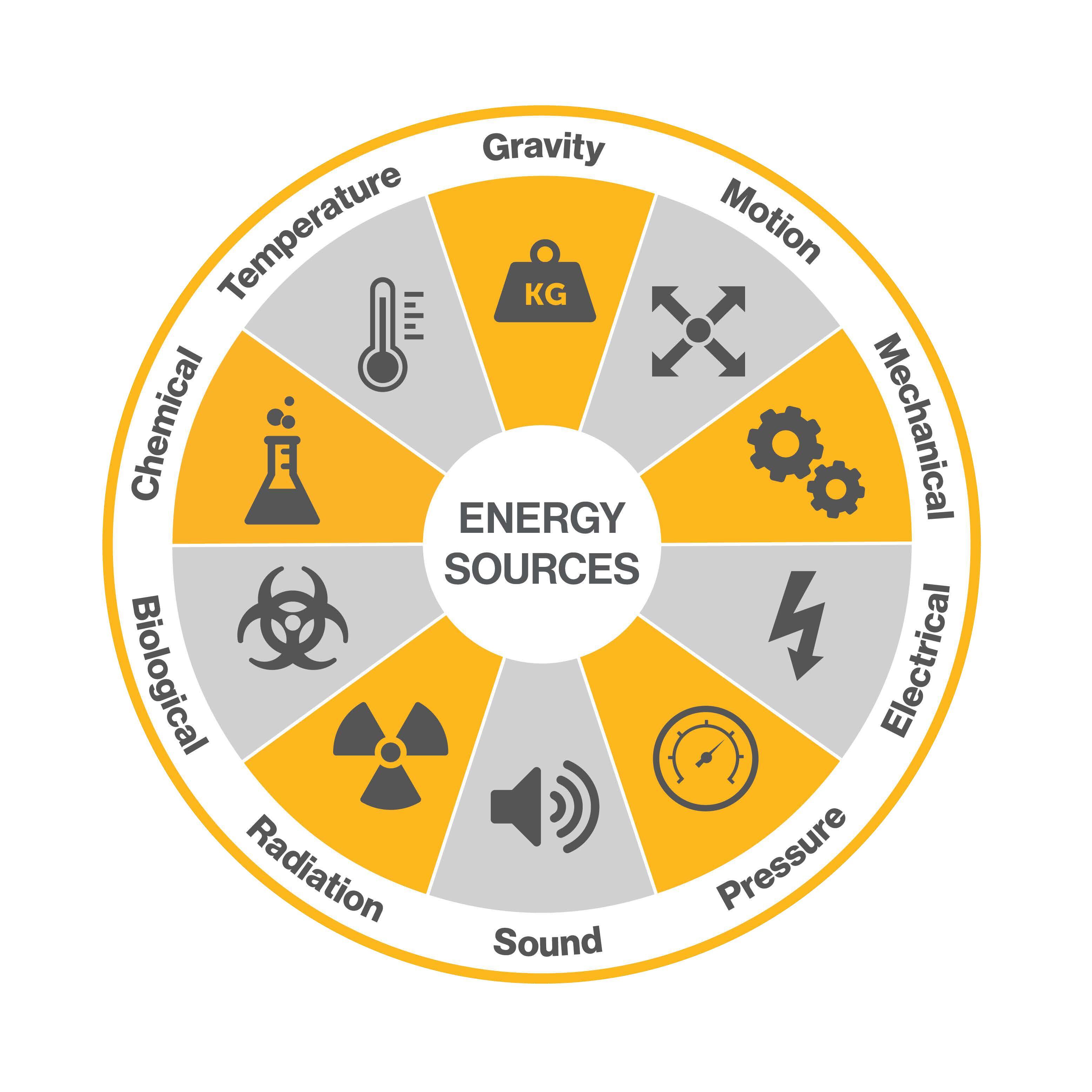Summary
-
Fatigue management technology enables proactive and reactive tools to mitigate worker fatigue across high-risk industries.
-
Solutions range from wearables and camera-based monitoring to predictive software like Readi.
-
Readi offers both a non-invasive software-only solution and an optional wearable to enhance fatigue risk insight.
-
Using fatigue tech reduces incidents, improves planning, and supports wellness across shifts.
-
Best practices include integrating tools into dispatch workflows, training supervisors, and maintaining worker privacy.
What Is Fatigue Management Technology?
Fatigue management technology includes the tools and systems used to detect, predict, and reduce fatigue in the workplace. These solutions are especially critical in operations where fatigue-related errors can have catastrophic consequences, such as mining, transportation, construction, logistics, oil and gas, and utilities.
From wearable biometric trackers to AI-powered predictive software, fatigue tech enables better shift planning, real-time intervention, and a measurable improvement in safety outcomes.
Types of Fatigue Monitoring Tools
1. Wearable Fatigue Monitoring Systems
These devices track physical and physiological signals like:
-
Heart rate variability
-
Motion and posture
-
Sleep duration and quality
Examples: ReadiWatch, Bodytrak, FatigueTech

Pros:
-
Personalized data
-
Useful for isolated or mobile workers
Cons:
-
Requires wear compliance
-
Raises potential privacy and data storage concerns
2. Camera-Based Fatigue Detection Technology
Mounted in vehicles or machinery, these systems monitor for physical signs of drowsiness—eye closure, head nodding, and inattention.
Examples: Caterpillar DSS, Seeing Machines
Pros:
-
Immediate feedback via alarms
-
Captures real-time signs of fatigue
Cons:
-
Often unpopular with workers due to privacy concerns
-
High rate of false positives
3. Predictive Fatigue Management Software
Platforms like Readi use AI and biomathematical modeling to forecast fatigue risk based on sleep, schedule, and circadian factors.
Key Features of Readi:
-
Software-only deployment or wearable-supported via ReadiWatch
-
Forecasts fatigue up to 30 days in advance
-
No surveillance or biometric tracking required for core functionality
-
Integrates into dispatch and supervisor workflows
-
Reduces alarm fatigue by up to 58% when paired with cameras
Readi: A Flexible, Predictive Fatigue Risk Platform
Readi, by Fatigue Science, offers a unique dual-approach to fatigue risk:
-
Software-Only Option: Perfect for union-sensitive, distributed, or privacy-concerned operations. Uses scheduling data to model fatigue risk for each worker.

-
Wearable-Supported Option: Workers use the ReadiWatch to log sleep data for enhanced ReadiScore accuracy. Syncing occurs pre-shift, without live tracking.
Supervisors use the ReadiScore dashboard to make data-informed decisions about task assignment, shift changes, or safety interventions.
Readi vs. Other Fatigue Management Technologies
| Feature | Wearables Only | Camera Systems | Readi (Software + Wearable Optional) |
|---|---|---|---|
| Data Source | Biometric | Visual monitoring | Schedule + sleep science + biometric optional |
| Requires Wearables | Yes | No | Optional (ReadiWatch) |
| Requires Cameras | No | Yes | No |
| Privacy Concerns | Medium | High | Low |
| Detection Timing | Ongoing/reactive | Real-time/reactive | Pre-shift/predictive |
| Worker Acceptance | Mixed | Low | High |
| Alarm Fatigue Risk | Low | High | Low |
| Integration with Dispatch | Rare | No | Yes |
| Union Compliance | Mixed | Often challenged | Approved |
How Fatigue Management Tools Improve Safety and Productivity
Deploying fatigue technology—especially predictive platforms like Readi—offers measurable advantages:
Prevents Incidents Before They Happen
Predictive tools flag high-risk individuals before their shift begins, enabling preventive action.
Improves Supervisor Decision-Making
Readi provides visual dashboards showing individual fatigue risk, enabling smarter crew assignments and task planning.
Reduces Alarm Fatigue and False Positives
Unlike camera-based systems that frequently issue alarms, Readi’s forecasting allows for preventive steps before alarms become necessary.
Supports Wellness and Engagement
Workers appreciate non-punitive approaches. Readi is non-intrusive, doesn’t surveil them, and empowers teams to manage fatigue as a shared safety responsibility.
Enhances Scheduling and Staffing Decisions
Readi’s predictive insights help schedulers avoid stacking fatigued workers on safety-critical tasks, improving safety and efficiency.
Best Practices for Implementing Fatigue Management Technology
To ensure success, safety and operations leaders should:
-
Conduct a Fatigue Risk Assessment
Identify high-risk roles, time windows, and work conditions where fatigue is most likely to impact performance.Download our fatigue risk assessment checklist to get started.
-
Pilot Predictive Tools Before Scaling
Start with a small team or shift. Assess impact, gather feedback, and refine protocols. -
Build Trust Through Transparency
Communicate how tools like Readi work, what data they use, and how privacy is protected, especially when wearables are used. -
Train Supervisors to Act on Data
Don’t just show fatigue scores—train leaders on how to adjust tasks, authorize stand-downs, or offer countermeasures like naps or breaks. -
Embed Technology in Daily Workflows
Use fatigue scores in dispatch software, pre-start meetings, and daily safety check-ins. Readi integrates easily into existing platforms. -
Monitor KPIs and ROI
Track incident reductions, productivity gains, and worker feedback.
FAQs
1. What is fatigue management technology?
Fatigue management technology like Readi helps organizations identify and mitigate workplace fatigue by providing predictive insights and, optionally, sleep data via wearables.
2. How does Readi differ from other fatigue tools?
Readi is predictive, not reactive. It offers a software-only model or an optional wearable, and it integrates directly into operational workflows.
3. What industries benefit most from fatigue management tools?
Any 24/7 or high-risk environment—mining, logistics, transportation, utilities, and manufacturing—sees immediate safety gains from Readi.
4. Can fatigue tech be used without violating privacy?
Yes. Readi is union-approved and does not track live behavior or collect biometric data unless wearables are explicitly enabled.
Related Posts
-
Shifting From Reactive Dash Cam Safety to a Proactive Safety StrategyDash cams are now common across trucking fleets, mine sites, and people-transport operations. They help reconstruct incidents,...
-
Why Fatigue Risk Management Is Becoming a Strategic Priority in Safety-Sensitive IndustriesFatigue has always existed in safety-sensitive industries. What has changed is how well we can see it and how quickly it can be...
-
How Energy-Based Hazard Recognition Reduces Risk in Mining Safety (And How Readi Amplifies the Impact)Summary In mining operations, hazard recognition is the frontline of safety. Yet, studies show that workers identify less than...



